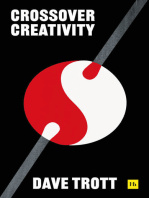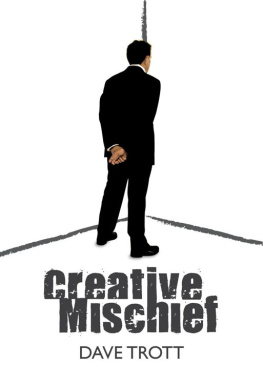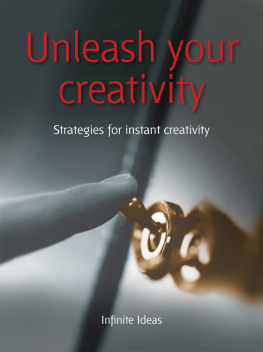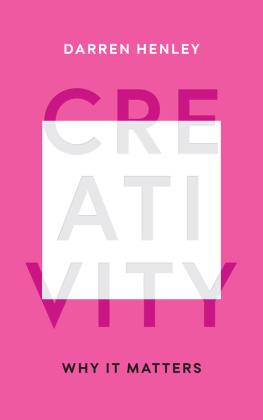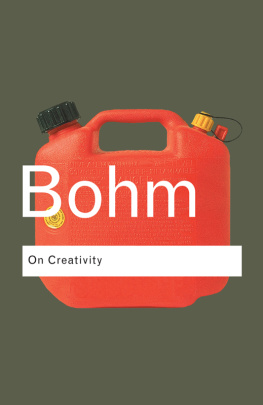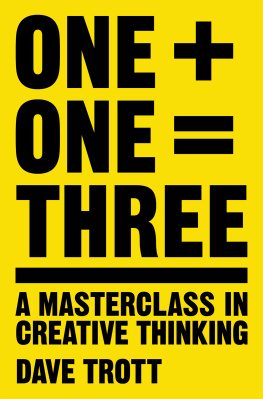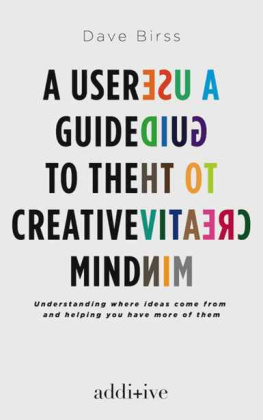Dave Trott - Crossover Creativity: Real-life stories about where creativity comes from
Here you can read online Dave Trott - Crossover Creativity: Real-life stories about where creativity comes from full text of the book (entire story) in english for free. Download pdf and epub, get meaning, cover and reviews about this ebook. genre: Detective and thriller. Description of the work, (preface) as well as reviews are available. Best literature library LitArk.com created for fans of good reading and offers a wide selection of genres:
Romance novel
Science fiction
Adventure
Detective
Science
History
Home and family
Prose
Art
Politics
Computer
Non-fiction
Religion
Business
Children
Humor
Choose a favorite category and find really read worthwhile books. Enjoy immersion in the world of imagination, feel the emotions of the characters or learn something new for yourself, make an fascinating discovery.
- Book:Crossover Creativity: Real-life stories about where creativity comes from
- Author:
- Genre:
- Rating:4 / 5
- Favourites:Add to favourites
- Your mark:
- 80
- 1
- 2
- 3
- 4
- 5
Crossover Creativity: Real-life stories about where creativity comes from: summary, description and annotation
We offer to read an annotation, description, summary or preface (depends on what the author of the book "Crossover Creativity: Real-life stories about where creativity comes from" wrote himself). If you haven't found the necessary information about the book — write in the comments, we will try to find it.
Crossover Creativity: Real-life stories about where creativity comes from — read online for free the complete book (whole text) full work
Below is the text of the book, divided by pages. System saving the place of the last page read, allows you to conveniently read the book "Crossover Creativity: Real-life stories about where creativity comes from" online for free, without having to search again every time where you left off. Put a bookmark, and you can go to the page where you finished reading at any time.
Font size:
Interval:
Bookmark:

Crossover Creativity
Real-life stories about where creativity comes from
Dave Trott

Creative Mischief
Predatory Thinking
One Plus One Equals Three: A Masterclass in Creative Thinking
Creative Blindness (And How To Cure It)
The Power of Ignorance
Dave Trott is a creative director, copywriter, and author. He studied at the Pratt Institute in New York City, majoring in advertising before going on to found the advertising agencies Gold Greenlees Trott, Bainsfair Sharkey Trott and Walsh Trott Chick Smith. In 2004 he was given the D&AD Presidents Award for lifetime achievement in advertising. He has also received lifetime achievement in advertising awards from The Creative Circle, The Marketing Society, and the Scottish Advertising Association.
Dave is married with two children and lives in London. Crossover Creativity is his sixth book.
Consider a Venn diagram either extreme on its own is boring, ordinary, predictable.
But move the two extremes together, so they overlap where they meet.
The overlap is the creative part, the electricity, that is where the magic happens: thats where two disconnected things form a third thing, a new thing.
The overlap didnt even exist until two unrelated things came together.
Then something springs into existence, something no one saw before.
Thats crossover creativity.
Thats what this book is about, putting things together.
Comparing and contrasting, collating and judging, seeking input and provocations.
Because thats what makes ideas.
To do that we need lots of input, and we need lots of differing perspectives:
Like crossing a hit music studio with an automobile production line.
Like using barbed wire to make phone calls.
Like comparing elephants to violent teenagers.
Like training soldiers via erotic comic books.
Like faking your own death for self-promotion.
Like getting a driver drunk to win a race.
Like turning the predator into the prey.
Like renaming a fish to make it taste delicious.
Like reporting on a football match in ancient Greek.
Like getting your main competitor to sell your product for you.
Like driving an F1 car in neutral to win a Grand Prix.
Like exchanging a paperclip for a house.
Like raising a million dollars by asking for a dime.
Like paying for fighter pilots to change sex.
Like buying books you couldnt even see or read.
Like rewriting basic numbers as an emotional, moving story.
Like paying for a fake painting with fake money.
Like using knitting, tin cups, even blinking to communicate.
Like editing the Bible with a razor blade to reveal the inner truth.
From all that, we can see that ideas dont just come out of nowhere.
Two things come together and a third thing happens.
Because new ideas are actually a reaction when existing things cross over.
They are the product of recombinant thinking.
All we have to do is keep putting things together and see how they react.
The more things we put together the more reactions we get.
The more reactions we get, the more ideas well have.
All we have to do is collect lots of different, unconnected things to put together.
Thats crossover creativity.
PART 1: LETTING IDEAS IN
In 1953, a young man left the army and got a job at Fords factory in Detroit.
He didnt want to work on the production line all his life, so he began writing songs.
Some were hits, so he quit his day job and began writing songs full time.
But he didnt want to lose control of the songs when they were recorded.
So he thought bigger, he began producing the recordings himself and selling his recordings to bigger labels to publish.
Which made him think, why dont I have my own label and publish them myself?
So, in 1959, he began publishing songs on his own label.
Which meant he could attract lots of young artists.
Which meant he could afford to turn his house into a recording studio.
Which meant he controlled the whole process, beginning to end.
But then he thought even bigger.
And this is where he put what hed learned at Fords production line together with the music business.
Hed seen the bare chassis of a car start at the beginning, then have the various components added: engine, transmission, seats, bodywork, wheels, windows, until by the end it was a complete, beautiful, finished car.
And thats what he wanted his artists to be: not just singers but complete entertainers.
He started with the raw talent, but he didnt just want voices people would listen to on records.
He wanted polished entertainers that people would pay to see perform.
So, like the production line, he added the parts as they went along.
He started with good singers, but then he had Maurice King, as Musical Director of Artistic Development, add sophistication and class to the artists.
He taught them how to project, how to phrase, how to blend, he arranged their music.
Then Cholly Atkins was added, to teach them stage presence.
So they didnt just stand and sing, or sit and sing, they had a complete choreographed performance with every song.
And as a finishing touch, Maxine Powell was added, to teach them dress and style and etiquette.
They learned to perform and speak and talk and even eat with elegance, so they would be at ease at the White House or Buckingham Palace.
And when the artists were rolling off the production line, just like at Ford, they were the finished complete product, unlike any other companies artists.
His record label employed 450 people, and had 110 top ten hits between 1960 and 1970.
The young mans name was Berry Gordy, and the record label he founded was Motown.
Some of the artists to roll off his production line are as follows:
Smokey Robinson & The Miracles, Diana Ross & The Supremes, Michael Jackson & The Jackson Five, The Four Tops, The Temptations, Marvin Gaye, Stevie Wonder, Lionel Richie, Tammi Terrell, Gladys Knight & The Pips, Al Green, The Isley Brothers, Mary Wilson, Eddie Kendricks, The Commodores, Junior Walker, The Pointer Sisters, Edwin Starr, and lots more.
All by ignoring the rules of the music business and making up his own rules.
By using what hed learned from a completely different business, the production line at Ford, and applying it to the music business.
He didnt try to do the music business the way everyone said it should be done.
But I often think thats how we do our jobs.
Frightened to step out of line in case anyone points the finger at us.
Frightened of not doing it the way everyone else agrees it should be done.
We are so worried about getting every little detail approved we forget to be exciting.
I think we forget this isnt school, this isnt university, this isnt an exam.
Most of us have different types of wine glasses at home why is that?
If asked, well probably say we need different glasses for different kinds of wine.
We might say red wine needs a wider glass for the fuller aroma, white wine needs a smaller, narrower glass for the more delicate flavour.
Next pageFont size:
Interval:
Bookmark:
Similar books «Crossover Creativity: Real-life stories about where creativity comes from»
Look at similar books to Crossover Creativity: Real-life stories about where creativity comes from. We have selected literature similar in name and meaning in the hope of providing readers with more options to find new, interesting, not yet read works.
Discussion, reviews of the book Crossover Creativity: Real-life stories about where creativity comes from and just readers' own opinions. Leave your comments, write what you think about the work, its meaning or the main characters. Specify what exactly you liked and what you didn't like, and why you think so.

